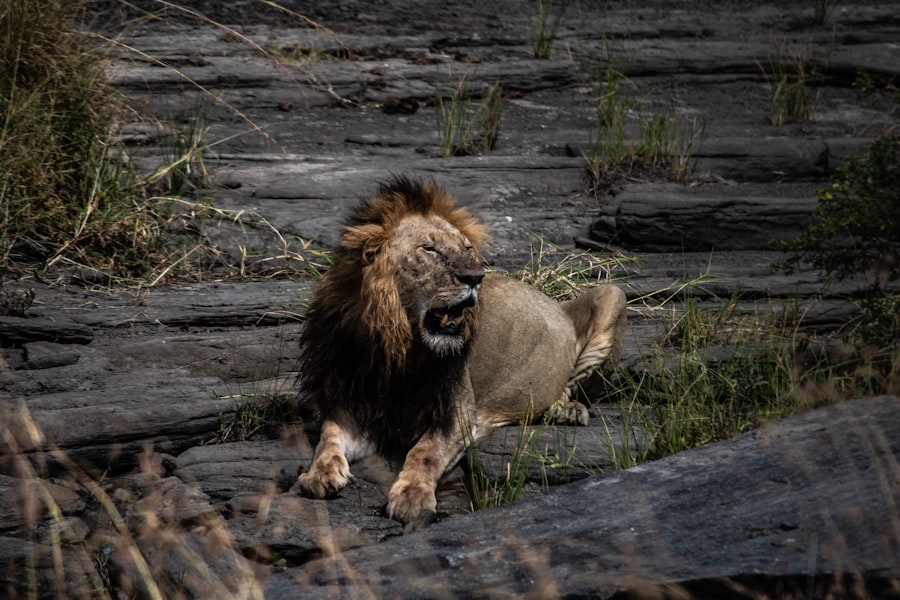Mechagodzilla first emerged in the 1974 film “Godzilla vs. Mechagodzilla,” marking a significant turning point in the Godzilla franchise. This formidable mechanical counterpart to the iconic kaiju was conceived as a response to the growing popularity of Godzilla, who had become a cultural phenomenon since his debut in 1954.
The creators sought to introduce a new layer of complexity to the narrative, pitting Godzilla against a foe that mirrored his own destructive capabilities but was crafted from metal and technology. This innovative approach not only showcased the ingenuity of the filmmakers but also tapped into the anxieties of the era, reflecting societal fears surrounding technological advancement and its potential consequences. The character of Mechagodzilla was born out of a desire to explore themes of artificiality and the clash between nature and technology.
In a world increasingly dominated by machines, Mechagodzilla represented humanity’s attempt to control and replicate the power of nature. The film’s narrative suggested that even the mightiest creature could be challenged by human ingenuity, setting the stage for a series of confrontations that would captivate audiences for decades. As you delve into the origins of Mechagodzilla, you can appreciate how this character not only served as an antagonist but also as a symbol of the complex relationship between humanity and its creations.
Key Takeaways
- Mechagodzilla was first introduced in the 1974 film “Godzilla vs. Mechagodzilla” as a weapon created by an alien race to conquer Earth.
- Over the years, Mechagodzilla’s design has evolved from a menacing, metallic doppelganger of Godzilla to a more sleek and futuristic appearance.
- Mechagodzilla is equipped with a wide range of abilities and weapons, including laser beams, missile launchers, and the ability to fly.
- Throughout the Godzilla franchise, Mechagodzilla has played various roles, from a villainous weapon to a heroic defender of Earth.
- Mechagodzilla has engaged in many memorable battles, including showdowns with Godzilla, King Caesar, and other kaiju, leaving a lasting impact on fans.
The Evolution of Mechagodzilla’s Design
Over the years, Mechagodzilla’s design has undergone significant transformations, reflecting advancements in special effects technology and shifts in audience expectations. Initially portrayed as a clunky, metallic doppelgänger of Godzilla, the original Mechagodzilla featured a design that emphasized its robotic nature with visible seams and mechanical joints. This design was both a product of its time and a testament to the creativity of the filmmakers, who worked within the constraints of practical effects to bring this mechanical titan to life.
As you examine the evolution of Mechagodzilla’s appearance, you can see how each iteration has sought to enhance its menacing presence on screen. In subsequent films, such as “The Return of Godzilla” and “Godzilla vs. Mechagodzilla II,” designers began to refine Mechagodzilla’s look, incorporating sleeker lines and more sophisticated features.
The introduction of advanced animatronics and CGI allowed for greater fluidity in movement, making Mechagodzilla appear more lifelike and formidable. Each new design not only aimed to impress audiences with visual spectacle but also sought to convey deeper themes about technology and its implications. As you explore these designs, consider how they reflect changing cultural attitudes toward machines and their role in society.
Mechagodzilla’s Abilities and Weapons

Mechagodzilla is not just a mere imitation of Godzilla; it is equipped with an impressive arsenal of abilities and weapons that make it a formidable opponent. From its inception, this mechanical beast has been armed with an array of destructive capabilities designed to counter Godzilla’s immense power. One of its most iconic features is the ability to unleash devastating energy beams from its mouth, often referred to as the “plasma grenade.” This weapon serves as a powerful reminder of humanity’s capacity for destruction, showcasing how technology can be wielded for both protection and annihilation.
In addition to its energy attacks, Mechagodzilla boasts an array of physical enhancements that allow it to engage in close combat effectively. Its metallic body is reinforced with armor plating, making it resistant to Godzilla’s attacks while enabling it to deliver punishing blows in return. The character has also been depicted with various gadgets, such as missile launchers and grappling claws, further expanding its combat capabilities.
As you consider these abilities, think about how they symbolize humanity’s desire to conquer nature through technology while also highlighting the inherent risks involved in such pursuits.
The Role of Mechagodzilla in the Godzilla Franchise
| Movie | Year | Role |
|---|---|---|
| Godzilla vs. Mechagodzilla | 1974 | Villain |
| Terror of Mechagodzilla | 1975 | Villain |
| Godzilla vs. Mechagodzilla II | 1993 | Anti-hero |
| Godzilla Against Mechagodzilla | 2002 | Villain |
| Godzilla: Tokyo S.O.S. | 2003 | Villain |
| Godzilla: Final Wars | 2004 | Villain |
Mechagodzilla occupies a unique position within the Godzilla franchise, serving as both an antagonist and a reflection of humanity’s relationship with technology. While initially introduced as a villain created by aliens seeking to conquer Earth, Mechagodzilla has evolved into a more complex character over time. In various films, it has been portrayed as a weapon developed by humans in response to Godzilla’s destructive rampages, illustrating the duality of creation and destruction inherent in technological advancement.
As you explore Mechagodzilla’s role in the franchise, you’ll notice how it often embodies the fears and aspirations of society at different points in history. In some narratives, it represents humanity’s hubris in attempting to control nature through technology, while in others, it serves as a protector against greater threats. This duality adds depth to the character and allows for rich storytelling opportunities that resonate with audiences on multiple levels.
By examining these narratives, you can gain insight into how Mechagodzilla reflects broader societal themes and concerns.
Mechagodzilla’s Most Memorable Battles
Throughout its cinematic history, Mechagodzilla has engaged in numerous epic battles that have left an indelible mark on fans of the franchise. One of the most memorable confrontations occurs in “Godzilla vs. Mechagodzilla” (1974), where the two titans clash in a battle that showcases their respective strengths and weaknesses.
This film not only introduced audiences to the concept of a mechanical Godzilla but also set the stage for future encounters between these iconic characters. The choreography of their fight sequences combined with practical effects created a thrilling spectacle that captivated viewers. Another notable battle takes place in “Godzilla vs.
Mechagodzilla II” (1993), where Mechagodzilla faces off against Godzilla once again, this time with enhanced capabilities and design. The stakes are raised as both titans unleash their full power in an explosive showdown that highlights their contrasting natures—one born from nature and the other forged from human ingenuity. As you reflect on these battles, consider how they not only serve as entertainment but also explore deeper themes about conflict, identity, and the consequences of technological advancement.
The Impact of Mechagodzilla on Pop Culture

Enduring Popularity
Mechagodzilla’s impact on pop culture is undeniable, with its influence extending beyond the realm of film to inspire a wide range of creative works. Its iconic design has been reproduced in various forms of merchandise, from action figures to video games, cementing its status as a cultural phenomenon.
Influence on the Mecha Genre
As a pioneering mecha character, Mechagodzilla has had a profound impact on the genre, shaping the way robots are portrayed in various forms of entertainment. Its presence has sparked discussions about technology’s role in society and our relationship with machines, often serving as a cautionary tale about humanity’s attempts to control nature through artificial means.
A Timeless Symbol
Today, Mechagodzilla’s significance extends beyond its origins as a monster to embody complex ideas that continue to provoke thought and inspire creativity. As we grapple with rapid technological advancements and their implications for our future, Mechagodzilla’s impact on pop culture serves as a reminder of the importance of critically examining our relationship with technology.
Mechagodzilla’s Influence on Mecha Kaiju in Film and Television
The influence of Mechagodzilla extends beyond its own franchise; it has played a pivotal role in shaping the portrayal of mecha kaiju in film and television. Its success paved the way for other mechanical monsters to emerge within the kaiju genre, each drawing inspiration from Mechagodzilla’s design and abilities. Characters like Gamera’s Gyaos or even newer entries like Pacific Rim’s Jaegers owe some of their conceptual roots to this iconic figure.
As you explore this influence, consider how Mechagodzilla has set a standard for what audiences expect from mecha kaiju. Its blend of advanced technology with monstrous characteristics has become a template for future creations, allowing filmmakers to experiment with themes of artificiality versus nature while delivering thrilling action sequences. By analyzing these influences, you can gain insight into how Mechagodzilla has shaped not only its own narrative but also the broader landscape of science fiction and fantasy storytelling.
The Future of Mechagodzilla in the Godzilla Universe
As we look toward the future of Mechagodzilla within the Godzilla universe, there are exciting possibilities on the horizon. With advancements in CGI and special effects technology continuing to evolve, filmmakers have unprecedented opportunities to reimagine this iconic character for new generations. Whether through remakes or original stories, there is potential for fresh narratives that explore Mechagodzilla’s complexities while addressing contemporary themes related to technology and environmentalism.
Moreover, as audiences become increasingly aware of global issues such as climate change and technological ethics, there is room for stories that delve deeper into these subjects through the lens of Mechagodzilla’s character. By examining humanity’s relationship with technology and nature through this mechanical titan’s journey, filmmakers can create compelling narratives that resonate with viewers on multiple levels. As you contemplate the future of Mechagodzilla, consider how this character will continue to evolve alongside societal changes while remaining an enduring symbol within the Godzilla franchise.
